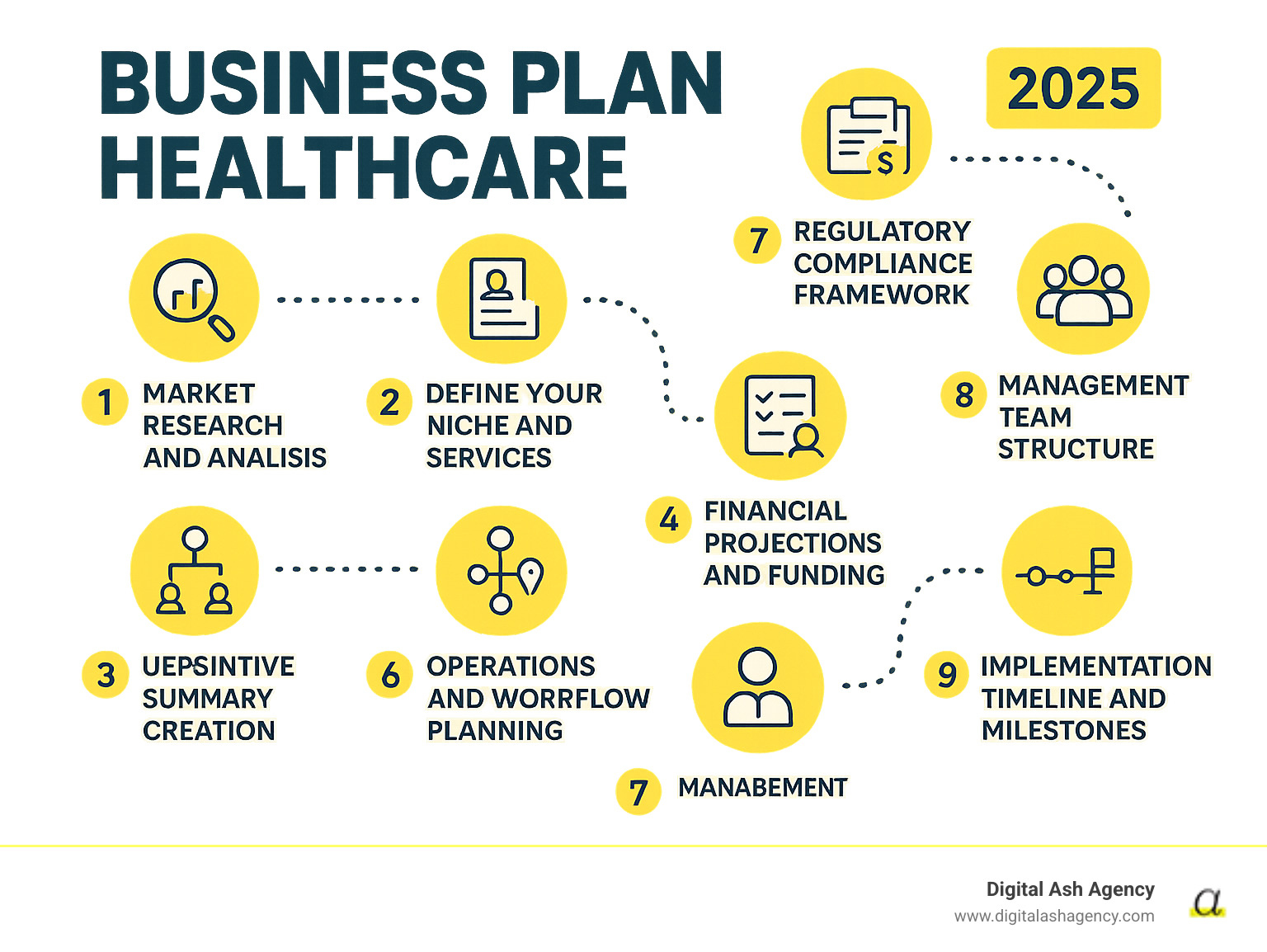
Your Roadmap to Success in a Complex Industry
A business plan healthcare venture requires is more than a document; it's a strategic roadmap through a complex and regulated industry. Whether launching a new practice, expanding services, or seeking funding, a well-crafted plan is your guide to navigating regulations, securing investment, and building sustainable patient care.
Essential Components of a Healthcare Business Plan:
- Executive Summary - Vision, mission, and financial highlights
- Market Analysis - Target demographics, competitor research, and industry trends
- Services & Operations - Detailed service offerings and operational workflows
- Marketing Strategy - Patient acquisition and retention tactics
- Financial Projections - 5-year forecasts, startup costs, and funding requirements
- Regulatory Compliance - HIPAA, licensing, and safety protocols
- Management Team - Key personnel and organizational structure
Healthcare business planning is unique. It involves managing insurance intermediaries, patient privacy laws, and lengthy provider credentialing, not just balancing profit margins. Did you know? If a practice plans to accept insurance from patients, providers must go through insurance credentialing, a process that may take several months.
The stakes are high. As one healthcare business planning expert notes: "Weak planning methods can lead to faulty assumptions and costly errors in new health care ventures," preventing achievement of both financial and clinical goals.
Your plan must address unique challenges: balancing community health with financial sustainability, managing payer relationships, and ensuring regulatory compliance. It's your blueprint for a practice that thrives despite non-compete agreements and competitive markets.
I'm Ashley Gay. I helped my physician husband build a practice that billed $239K in its first 90 days and nearly $1 million in its first year, despite a non-compete. A solid business plan healthcare foundation was key, and I'll show you how to create yours.

Laying the Groundwork: Unique Considerations and Market Research
Before writing your business plan, you must understand the unique healthcare landscape. This phase involves strategic planning and detective work to steer rules and challenges that differ from any other industry.
Unique Challenges in Healthcare Business Planning
A business plan healthcare venture requires navigating obstacles not found in other sectors. You're dealing with people's health, sensitive data, and complex financial structures.
- Insurance intermediaries add complexity. Unlike direct customer payments, healthcare involves a web of insurance companies. Your payer mix (private insurance, Medicare, Medicaid) significantly impacts revenue and cash flow.
- Patient privacy laws like HIPAA are non-negotiable. Violations carry severe penalties, so every process must be designed for compliance.
- High startup costs are common. Medical equipment, specialized software, facility needs, and liability insurance require substantial upfront investment.
- Balancing community needs and profitability is a key challenge. As a vital community service, you may need to provide less profitable care to serve the greater good.
- Regulatory complexities involve a maze of changing federal, state, and local rules. Non-compliance has serious consequences. The U.S. Department of Health & Human Services offers comprehensive regulatory complexities information.
- Credentialing delays can derail a launch. Did you know? If a practice plans to accept insurance from patients, providers must go through insurance credentialing, a process that may take several months. This means you could be open for business but unable to collect revenue from insured patients.
These factors require a specialized healthcare business plan, not a generic template.
Conducting Market Research for Your Business Plan Healthcare
Healthcare market research involves analyzing a complex ecosystem of patients, providers, payers, and regulations.

Start with competitor analysis of both direct and indirect competitors, such as retail clinics, urgent care centers, and telehealth services. Analyze industry trends like telehealth adoption or demand for preventative care to identify opportunities and threats. Identifying underserved populations can reveal major opportunities, guiding service design and potentially leading to grants or partnerships.
Practitioner-to-population ratios gauge market saturation. High ratios mean more competition; low ratios suggest unmet demand. A thorough SWOT analysis (Strengths, Weaknesses, Opportunities, Threats) connects your internal capabilities with external market conditions. The Small Business Administration offers valuable guidance on conducting effective market research. This research provides a data-driven foundation for your business plan healthcare strategy, ensuring it's grounded in reality.
Defining Your Niche and Target Audience
After market research, define your niche by deciding on your services and target audience.
Specialty selection (e.g., primary care, telehealth, midwifery) is core to your identity and impacts costs, regulations, and marketing. Define target patient demographics beyond age and income to include insurance status, location, and lifestyle. Create detailed patient personas to design patient-centered services. A persona includes demographics, health concerns, and preferences, like "Sarah, 32, a working mother seeking convenient family care."
A community health needs assessment, using local health department data, helps align your services with community needs and identify partnership opportunities. Providing services for underserved communities can differentiate your practice, fulfill a social mission, and attract mission-driven staff and funding.
Clearly defining your niche and audience makes your business plan healthcare strategy focused and relevant, guiding all subsequent decisions.
The Anatomy of a Winning Business Plan for Healthcare
With the groundwork laid, it's time to build the core sections of your business plan healthcare document. Each part must be carefully crafted and connected to create a cohesive and impressive blueprint for your practice.
Executive Summary and Company Overview
This section is your first impression. It must be professional and clearly communicate your vision.

Your executive summary is your elevator pitch. It must be compelling for investors and lenders, covering your business concept, market opportunity, services, team, and key financial projections. Pro-tip: Write this section last, after you've detailed all other parts of your plan.
The company overview tells your story. Your mission statement should clearly state your purpose, the problem you solve, and your driving values. Your vision statement describes your future goals, such as becoming the community's go-to practice. Choosing your legal structure (e.g., sole proprietorship, PLLC, corporation) is a critical decision affecting taxes, liability, and fundraising. The SBA offers helpful legal structure guidance.
For established practices, the company history section should highlight key milestones and achievements to build credibility. Your core values should be authentic and guide every action, from patient care to business operations.
Services, Operations, and Management
This is where you detail the day-to-day functions of your practice.
When describing services and products, detail the patient experience. For example, a midwifery practice offers comprehensive prenatal, labor, and postpartum support, not just "birth services." Detail what makes your patient experience unique, your quality assurance methods, and your pricing and insurance reimbursement strategies.
Define your operational workflow, mapping the patient journey from scheduling to check-out. Your medical record system must ensure HIPAA compliance and patient safety. Develop robust standard operating procedures for data handling and supply management.
Your staffing model should detail team size and required qualifications. Consider roles like a Wellness Coordinator or investments in specialized training to strengthen your operation. Define your organizational structure with clear reporting lines and responsibilities, and develop staff training programs to ensure high-quality, safe patient care.
In the management team section, highlight the expertise and story behind each key person. An advisory board can fill expertise gaps and add credibility.
Key Stakeholders and Their Impact
Success in healthcare requires managing relationships with various key stakeholders. Understanding their motivations is crucial.
- Regulators (e.g., CMS, HHS, state boards) set non-negotiable rules. Compliance is mandatory to operate.
- Providers are critical partners. Referrals, hospital privileges, and lab partnerships directly impact patient flow and community reputation.
- Payers are a complex group, including patients, private insurers, and government programs. Remember to factor in the lengthy insurance credentialing process.
- Suppliers for medical equipment and office supplies must be reliable. Delays can disrupt patient care.
- Community partners like schools and public health initiatives can expand your impact.
- Patient advocacy groups provide valuable insights into patient needs. Engaging with them demonstrates a commitment to patient-centered care.
Mapping these stakeholder relationships builds a more resilient and successful business plan healthcare strategy.
Strategic Planning: Marketing, Financials, and Compliance
This section covers three critical areas for any healthcare practice: attracting patients, managing finances, and ensuring regulatory compliance. This is where your strategy meets reality in your business plan healthcare venture.
Developing an Effective Marketing and Sales Strategy
Even the best providers need marketing. An effective strategy connects you with patients and builds community trust.
Digital marketing is key for patient acquisition. Use SEO to improve search visibility, social media to engage the community, and content marketing (blogs, videos) to establish expertise. Physician referrals are a powerful acquisition channel; strong relationships with other providers create a steady stream of high-trust patients. Community outreach, such as sponsoring health fairs or giving educational talks, builds local trust and awareness.
Patient retention is cost-effective. An exceptional patient experience creates loyal advocates whose testimonials become powerful marketing tools.
For new practices, getting the word out can be overwhelming. At Digital Ash Agency, we specialize in marketing and networking strategies custom-built for healthcare practices. We help you build relationships and thrive, even when navigating non-compete agreements and competitive markets. Learn more about our approach: Services for New Practices. You can see examples of our past successes here: Our Work.
Developing Financial Projections for Your Business Plan Healthcare
Financial projections are your roadmap to sustainability and an early warning system.

Create 5-year financial projections (monthly for year one, then annually). Detail all startup costs, including facility build-out, equipment, fees, and marketing, and account for hidden costs like revenue delays from credentialing. Your 5-year financial statements must include a profit and loss statement, a cash flow statement, and a balance sheet.
Your funding request must be specific: state the amount needed, its exact use, and its expected impact. A break-even analysis identifies the patient volume needed to cover all costs. Base all projections on realistic, well-researched key financial assumptions (e.g., patient volume, revenue per visit). Overly optimistic figures undermine credibility. Robust financial projections are one of the most essential components of a credible business plan healthcare strategy.
Addressing Regulatory Compliance and Data Security
In healthcare, compliance is survival. Ignoring regulations leads to severe penalties and reputation damage.
HIPAA compliance is central. Your plan must detail policies for protecting patient data to maintain trust. Patient data security requires comprehensive cybersecurity to protect digital systems, including encryption, access controls, security audits, and a data breach response plan. Malpractice insurance is essential protection against liability claims.
Additional regulations may apply depending on your services, such as CLIA for labs, OSHA for workplace safety, and DEA for controlled substances. Licensing and accreditation are non-negotiable. Plan for all necessary licenses and accreditations to show your commitment to quality. Take a proactive approach to regulatory compliance with proper staff training and procedures to build a practice with integrity.
Frequently Asked Questions about Healthcare Business Plans
I often get questions from providers working on their business plan healthcare strategy. Here are answers to the most common ones.
What are the most common mistakes to avoid when creating a healthcare business plan?
Here are common, avoidable mistakes in healthcare business planning:
- Rushing the process: A solid plan takes weeks of careful work, not days.
- Unrealistic financial projections: Base your numbers on solid research and conservative estimates to maintain credibility.
- Neglecting competitor analysis: Thoroughly research your competitors by visiting them, inquiring about services, and checking online reviews.
- Vague descriptions of services: Be specific. Instead of "quality healthcare," detail your offerings, such as "family medicine with same-day sick visits and evening hours."
- Ignoring regulatory requirements: Compliance with HIPAA, licensing, and credentialing is mandatory and must be a central part of your plan.
- Not involving key team members: Include your team in the planning process to gain valuable insights on patient flow, billing, and more.
How often should a healthcare business plan be updated?
Your business plan healthcare practice needs is a living document, not a one-time task. It requires regular updates.
Update your plan at least annually, with quarterly reviews, as the healthcare industry changes rapidly. You must update for major events like:
- Shifts in services (e.g., adding telehealth)
- Changes in cash flow or financial challenges
- New market conditions (e.g., a competitor opening or closing)
- Regulatory changes (e.g., new HIPAA rules)
- Adoption of new technology
For established practices looking to stay competitive, we offer specialized services to help refine and update existing business plans: Services for Established Practices.
What makes a healthcare business plan different from other industries?
A healthcare business plan is fundamentally different from those in other industries for several key reasons:
- Insurance Intermediaries: Healthcare involves a complex web of third-party payers, creating complicated billing and reimbursement cycles.
- Regulatory Environment: The industry is governed by a dense network of regulations, including HIPAA and provider credentialing, far exceeding most other sectors.
- Patient Privacy and Data Security: Handling sensitive health information requires stringent security measures mandated by laws like HIPAA.
- Ethical Dimension: Plans must balance financial viability with the ethical duty to provide quality care and serve community health needs.
- Unique Financial Model: Healthcare features longer revenue cycles, higher startup costs, and less predictable patient volume.
- Service-Based Model: Healthcare is a service built on trust and relationships, requiring a relationship-focused strategy.
For these reasons, a generic business plan template is insufficient; a specialized approach is required for any business plan healthcare venture.
Conclusion: Turning Your Plan into a Thriving Practice
Creating a business plan healthcare venture requires is more than a checklist item; it's the foundation for your success, guiding you through regulations and financial planning. The key components—market research, financial projections, and a compliance strategy—are the building blocks of a resilient practice.
A plan is useless without action. Execution is what transforms a plan into a thriving healthcare organization that impacts the community.
Your plan must be a living document, updated regularly to adapt to the constantly changing healthcare landscape. This adaptability is key to long-term success. Remember your mission: to build a practice that is not only financially successful but also trusted by patients, respected by peers, and vital to your community.
A well-crafted business plan healthcare strategy is your roadmap to creating a sustainable organization that flourishes and makes a lasting impact on community health.
Ready to turn your carefully crafted marketing strategy into real patients walking through your doors? At Digital Ash Agency, we specialize in helping healthcare practices just like yours steer competitive markets and build the relationships that fuel long-term success. We understand the unique challenges you face, and we're here to help you thrive. Find how we can lift your practice to new heights: Digital Ash Agency Homepage.







